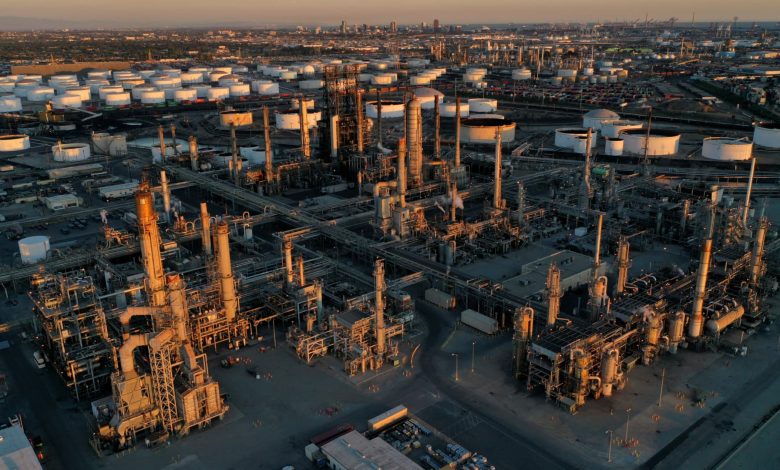Why OPEC+ is accelerating oil production as prices tank, tariffs hit

The Phillips 66 Company’s Los Angeles Refinery in California.
Bing Guan | Reuters
The oil price outlook is being hit with more bearish forecasts on the back of U.S. President Donald Trump’s sweeping and market-hammering tariff announcements. Businesses and investors worry that a trade war and lower global growth lies ahead.
Goldman Sachs on Thursday reduced its December 2025 forecasts for global and U.S. benchmarks Brent crude and WTI by $5 to $66 and $62 a barrel, respectively, “because the two key downside risks we have flagged are realizing, namely tariff escalation and somewhat higher OPEC+ supply.”
The bank also cut its forecasts for the oil benchmarks in 2025 and 2026, adding that “we no longer forecast a price range, because price volatility is likely to stay elevated on higher recession risk.” Analysts at S&P Global Market Intelligence predict that in a worst-case scenario, global oil demand growth could be slashed by 500,000 barrels per day.
JPMorgan, for its part, raised its recession odds for the global economy to 60% for this year, up from a previous forecast of 40%.
Markets were therefore stunned when OPEC, which produces about 40% of the world’s crude oil — along with its non-OPEC allies that together comprise OPEC+ — chose not only to go ahead with its previously held plans to increase oil production, but also to nearly triple the expected increase figure.
Eight key OPEC+ producers on Thursday agreed to raise combined crude oil output by 411,000 barrels per day, speeding up the pace of their scheduled hikes and pushing down oil prices. The group — Saudi Arabia, Russia, Iraq, the United Arab Emirates, Kuwait, Kazakhstan, Algeria, and Oman — was widely expected to implement an increase of just under 140,000 barrels per day next month.
The news pushed oil prices 6% lower.
OPEC+ bullishness and appeasing Trump
Several factors underpin the oil-producing alliance’s decision. One is that the group is bullish on oil demand later in the year, putting it firmly in the minority as investor outlooks sour and fears of a global slowdown worsen.
The eight OPEC+ members behind the production decision cited “the continuing healthy market fundamentals and the positive market outlook” in their statement Thursday, saying that “this measure will provide an opportunity for the participating countries to accelerate their compensation.”
The statement added that “the gradual increases may be paused or reversed subject to evolving market conditions.”
Another likely reason for the group’s move has to do with another T-word: the man in the White House, who during his first term in office and from the very start of his second, has loudly demanded that the oil producer group pump more crude to help bring down prices for Americans.
“First of all, this is partly about appeasing Trump,” Saul Kavonic, head of energy research at MST Marquee, told CNBC’s Dan Murphy on Friday.
“Trump will be putting pressure on OPEC to reduce oil prices, which reduces global energy prices, to help offset the inflationary impact of his tariffs.”
OPEC officials have denied that the move was made to appease Trump.
Compliance and market share
Meanwhile, as compliance is a major issue for OPEC+ — with countries overproducing crude beyond their quotas, complicating the group’s efforts to control how much supply it allows into the market — the move could be a way to enforce that, according to Helima Croft, head of global commodity strategy and MENA research at RBC Capital Markets.
“We think a desire by the OPEC leadership to send a warning signal to Kazakhstan, Iraq, and even Russia about the cost of continued overproduction underlies the decision.”
Helima Croft
head of global commodity strategy and MENA research at RBC Capital Markets
“We think a desire by the OPEC leadership to send a warning signal to Kazakhstan, Iraq, and even Russia about the cost of continued overproduction underlies the decision,” Croft wrote in a note published Thursday. She referenced the March 2020 oil price war, when Saudi Arabia flooded the market with supply to tank oil prices and forced Russia back into compliance after Moscow initially refused to curb production to help the alliance stabilize prices. The price war caused Brent crude prices to go as low as $15 a barrel.
The production increases are also “an example of OPEC increasing their market share,” Kavonic said, adding that it “ultimately does come at the expense of the United States [shale] patch,” which U.S. producers likely will not be too thrilled about.
What happens next?
OPEC+ appears confident about the market turning a corner in the coming months on the assumption that oil demand will increase in the summer and the tariff wars will be resolved in the coming months, said Nader Itayim, editorial manager at Argus Media.
“These countries are largely comfortable with the $70, $75 per barrel band,” Itayim said.
What comes next depends on the trajectory of the tariffs and a potential trade war. Oil dropping into the $60 range could force pauses or even a reversal in OPEC+ production increase plans, analysts say – although that is likely to be met with resistance from countries like Iraq and Kazakhstan that have long been itching to increase their oil production for their own revenues.
Whatever happens, the group maintains the flexibility to adapt its plans month by month, Itayim noted.
“If things don’t quite go the way they imagine, all it does take, really, is a phone call.”



